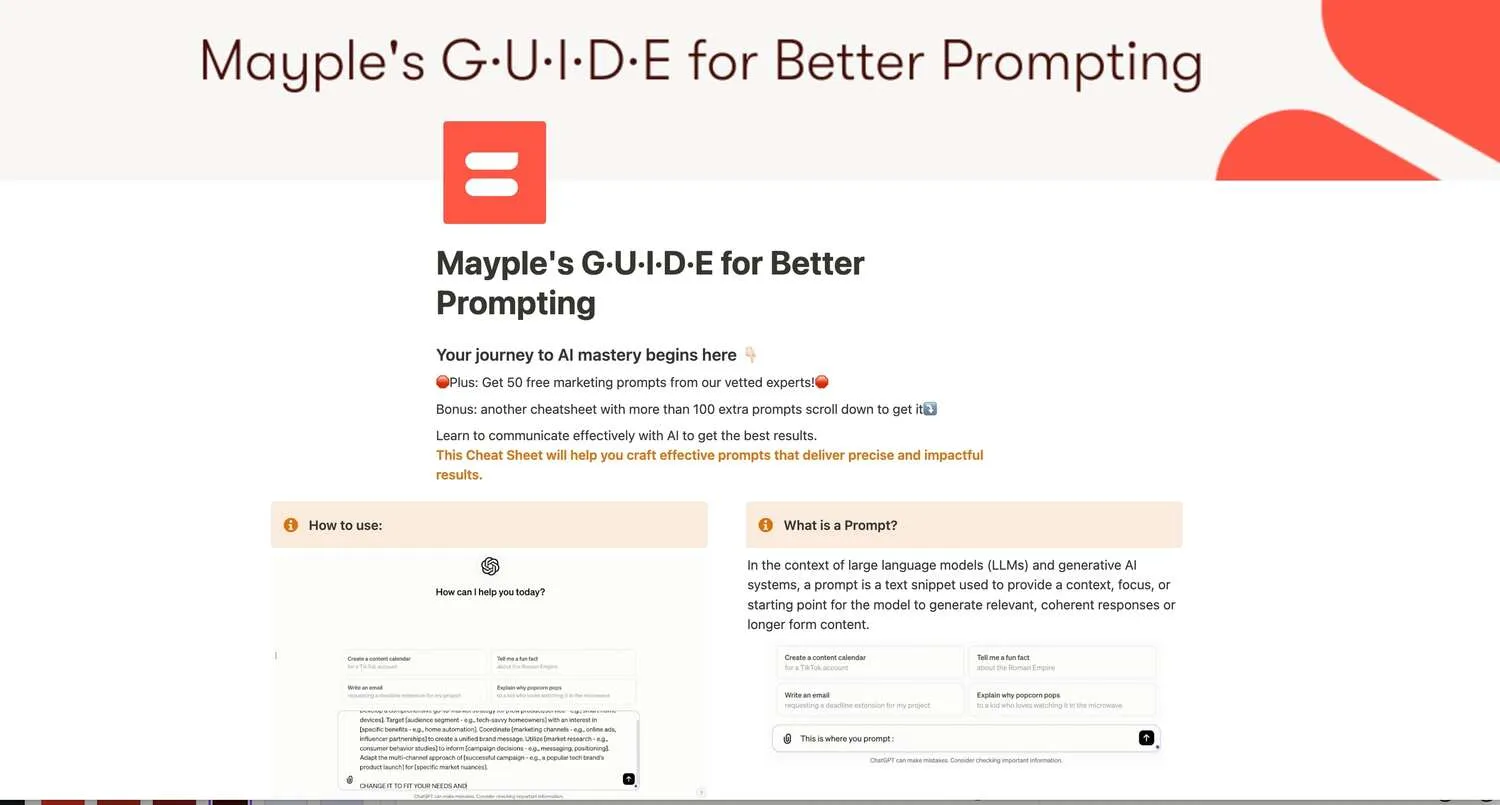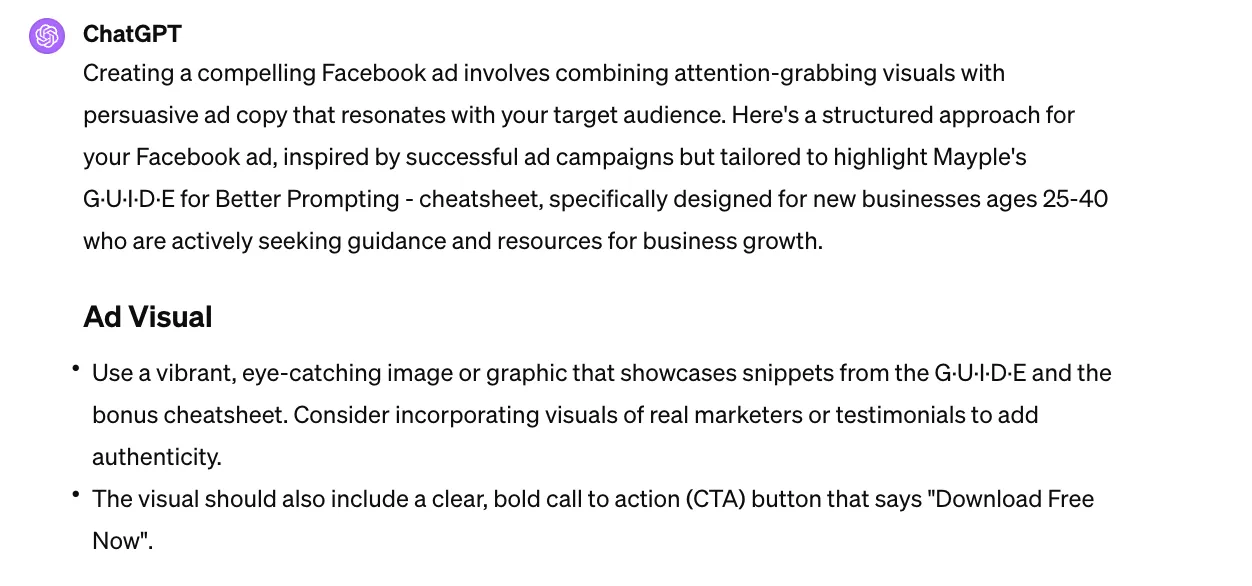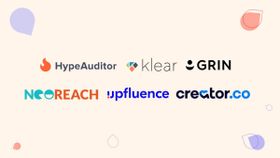50+ Best ChatGPT Prompts for Marketing + Examples
Here are the top 50+ ChatGPT AI prompts from our top experts. We cover email marketing, social media, marketing strategy, ads, and more.
Updated March 20, 2024

Any Joe Shmo can post a ChatGPT prompt on LinkedIn and promise that it will give you instant results. And we all know results are few and far between. What truly sets successful marketing campaigns apart is the art of prompt engineering - crafting compelling messages that resonate with consumers on a deeper level.
As a seasoned marketer, who works in a platform for hiring on-demand marketing talent, I've witnessed firsthand the transformative impact of well-crafted prompts on campaign performance.
Imagine tapping into the full potential of AI tools like ChatGPT, generating content that not only informs but truly connects with your audience.
The key lies in understanding the nuances of prompt design, a skill that can elevate your marketing efforts to new heights. That skill is what set us to create Mayple's latest innovation, the G.U.I.D.E for Better Prompting cheat sheet.
But first, let's cover the basics.
What is a prompt, and why does it matter?
A prompt is more than just a question or a set of instructions. it's a strategic tool used to guide large language models (LLMs) toward generating outputs that resonate with your marketing goals and audience's needs. toward
Your prompts need to be clear and structured for these tools to work. Vague or unethical prompts can lead to irrelevant or even harmful outputs. On the other hand, well-crafted prompts can unlock AI's full potential, delivering precise, relevant, and creative content that aligns with your marketing strategies.
This is where the importance of prompt engineering comes into play.
The Importance of prompt engineering
Prompt engineering is crucial for maximizing the potential of AI tools and LLM's in content creation and marketing strategies. By crafting prompts that are clear, detailed, and tailored to your audience's needs, you can unlock the full power of these AI assistants.
Well-engineered prompts result in more relevant, engaging, and persuasive content, driving better interactions, conversions, and overall marketing success. AI's capabilities can be effectively leveraged, and businesses can gain a competitive edge today by mastering this skill.
To help you master this crucial skill, we present the G·U·I·D·E framework – a comprehensive approach to crafting effective prompts that drive engagement and conversions.
The G·U·I·D·E framework
The G·U·I·D·E framework can help you create more effective prompts that drive engagement and conversions. This framework was developed by Evolving AI, a community of AI enthusiasts who share everything about AI.
The G·U·I·D·E framework is a comprehensive methodology designed to extract high-quality responses from AI models like ChatGPT and Claude. This framework acts as a coach, providing a structured approach to crafting prompts that ensure the AI delivers top-notch results every time.
The acronym stands for:
🎯G (Goal) 🎯 - Define what you want to achieve.
👤U (User)👤 - Understand your audience's needs.
📝I (Instructions)📝- Provide clear and concise directions.
🔎D (Detail)🔎 -Add relevant details for context.
🧐E (Examples)🧐 Use examples for better guidance
Why do you need the framework? It serves as a great reminder to include all the information you need in your prompt. Often people forget to describe their user, who they are creating the content for, or to provide enough details to the AI.
This approach enables you to create compelling, personalized, and high-converting content that drives your marketing efforts to new heights, giving you a competitive edge in today's digital landscape.
Let's dive into some examples across different marketing categories to showcase the power of G·U·I·D·E framework:
Prompts for social media
Here are a few effective ChatGPT marketing prompts for creating engaging social media posts.
Create a month of content
Plan a month of content on [platform - e.g., Instagram] to introduce [product/service - e.g., wireless earbuds]. Target [audience - e.g., tech enthusiasts, audiophiles] with posts that highlight [product feature - e.g., high-quality sound, wireless design]. Curate [content type - e.g., daily tech tips, unboxing videos] to [action - e.g., reveal the gadget's sleek design, showcase usability]. Feature [media types - e.g., user-generated content, behind-the-scenes videos] to spotlight [product USPs - e.g., battery life, connectivity]. Adapt the content style of [industry example - e.g., influential tech bloggers] while embedding [your brand's unique tone and ethos].
Here is a screenshot of what we got when we used this prompt to get a month's worth of content to promote this cheat sheet.
Remember to edit for clarity and the right tone of voice and add any relevant hashtags. The more you use this prompt, the better the content you will get.
Boost brand awareness
Boost brand awareness on [platform - e.g., Facebook] for [product/service - e.g., eco-friendly water bottles]. Engage [target audience - e.g., fitness enthusiasts, environmentally conscious consumers] interested in [product feature - e.g., sustainability, health benefits]. Share [content type - e.g., infographics, testimonials] that [action - e.g., educates about plastic pollution, demonstrates product durability]. Use [media types - e.g., user testimonials, product demos] that showcase [product USPs - e.g., bottle's unique design, eco-benefits]. Follow the stylistic approach of [industry example - e.g., a successful fitness influencer's product feature], while maintaining [your brand's voice and values].
Create an Instagram story to promote your product
Develop a series of Instagram Stories to promote [product/service - e.g., biodegradable packaging]. Target [audience - e.g., eco-conscious businesses, environmentally aware consumers] with stories that underscore [product feature - e.g., sustainability, waste reduction]. Produce [content type - e.g., behind-the-scenes tours, impact testimonials] that [action - e.g., illustrates production ethics, demonstrates real-world applications]. Incorporate [media types - e.g., live Q&A sessions, before-and-after scenarios] to vividly present [product USPs - e.g., compostability, durability]. Adopt the narrative style of [industry example - e.g., successful environmental campaigns] while ensuring [your brand's voice is clear and consistent].
Develop a Twitter hashtag campaign
Create a Twitter hashtag campaign to celebrate success stories with [product/service - e.g., online learning platform]. Reach out to [target audience - e.g., lifelong learners, professional upskillers] using hashtags that collate [product feature - e.g., course diversity, user achievements]. Share [content type - e.g., user accomplishments, motivational quotes] under the campaign hashtag to [action - e.g., inspire new learners, foster a community of achievers]. Employ [media types - e.g., graphic testimonials, short success clips] to amplify [product USPs - e.g., effective learning paths, career impact]. Channel the spirit of [industry example - e.g., motivational speaker campaigns] while ensuring [your brand's tone and message resonate throughout].
Create a LinkedIn Poll to understand consumer preferences on your product
Launch a LinkedIn poll to gather insights on [product/service - e.g., professional development courses]. Engage [target audience - e.g., career-focused professionals, lifelong learners] to uncover preferences on [product feature - e.g., course topics, learning formats]. Post [content type - e.g., follow-up discussions, analysis infographics] based on poll outcomes to [action - e.g., inform course development, adjust marketing strategies]. Utilize [media types - e.g., engaging visuals, short video clips] to encourage participation and share [poll results, key insights]. Emulate the interactive approach of [industry example - e.g., leading online education platforms] while retaining [your brand's communicative style and principles].
Paid ads prompts
You can do a ton with ChatGPT for your advertising campaigns. As long as you give it your target demographic and describe your target customer then you should get a good output.
Here's a great prompt for creating ad copy
Create an ad that is [adjective - persuasive, compelling] for [platform - Facebook, Google Ads]. For [demographic - young professionals, parents] interested in [product type - eco-friendly products, technology]. The ad copy should include [key selling points - affordability, convenience] and a [strong call to action]. Highlight [unique selling proposition - sustainability, innovative design] and [limited-time offer or discount]. Similar to [successful ad campaign example], but tailored for [specific product or service].
Here are screenshots of what we got when we used this prompt to create an ad to promote this cheat sheet :
Prompts for creating a marketing strategy
Develop a digital marketing strategy
Develop a comprehensive go-to-market strategy for [new product/service - e.g., smart home devices]. Target [audience segment - e.g., tech-savvy homeowners] with an interest in [specific benefits - e.g., home automation]. Coordinate [marketing channels - e.g., online ads, influencer partnerships] to create a unified brand message. Utilize [market research - e.g., consumer behavior studies] to inform [campaign decisions - e.g., messaging, positioning]. Adapt the multi-channel approach of [successful campaign - e.g., a popular tech brand's product launch] for [specific market nuances].
Create a rewards / loyalty program strategy to improve engagement
Increase [metric - e.g., customer retention rate] by [target percentage] through a [customer loyalty program]. Engage [existing customer base - e.g., monthly subscribers] with [incentives - e.g., rewards, exclusive content]. Implement [tactics - e.g., personalized email campaigns, VIP services] to enhance [customer satisfaction and loyalty]. Highlight [customer success stories] and [program benefits] to demonstrate value and foster community. Emulate [successful loyalty programs - e.g., Amazon Prime], with a twist that emphasizes [your brand's unique offerings].
Expand market share
Expand market share in [target region - e.g., Asia-Pacific] for [product line - e.g., organic skincare]. Target [demographic - e.g., millennials] who prioritize [values - e.g., eco-friendliness, health]. Utilize a mix of [channels - e.g., social media, influencer partnerships] to build brand presence. Leverage [brand USPs - e.g., zero-waste packaging] and [local trends - e.g., preference for organic products]. Inspired by [brand's successful strategy in a different market], adapted for [regional specifics].
Enhance online sales conversion rate
Enhance online sales conversion rate by [specific percentage - e.g., 20%] over [time period - e.g., Q3]. Focus on [customer segment - e.g., repeat customers] and [new prospects - e.g., via lead generation campaigns]. Streamline [customer journey - e.g., from discovery to purchase] using [tactics - e.g., targeted landing pages, chatbots]. Analyze [customer data - e.g., past purchase behavior] to personalize [marketing messages]. Model after [industry leader's conversion strategy], with a focus on [highly personalized experiences].
SEO prompts
Here are a few effective ChatGPT prompts to improve your search rankings and create better content. Now remember, that the output will be crap without some editing. Yes, human touch is still important to have in every piece of content you publish.
A prompt for creating better content
Achieve a first-page ranking for [primary keyword - e.g., vegan leather shoes]. Target [audience - e.g., ethical fashion shoppers] searching for [related terms - e.g., cruelty-free footwear]. Optimize on-page elements with [SEO best practices - e.g., meta tags, headings] and [keyword placement]. Provide in-depth content on [subject - e.g., the benefits of vegan leather] with [rich media - e.g., infographics, videos]. Emulate the SEO success of [industry leader - e.g., a well-known ethical fashion brand] in their [specific content - e.g., blog posts].
Optimize your meta description
Optimize the [type of content - e.g., product descriptions, category pages] for [long-tail keywords - e.g., organic cotton children's wear]. Focus on [specific user intent - e.g., parents looking for sustainable kids' clothing]. Include [semantic keywords - e.g., eco-friendly, hypoallergenic] and [clear CTAs - e.g., shop now, learn more]. Use [content features - e.g., size guides, fabric care instructions] that enhance user experience and dwell time. Take cues from [SEO leader - e.g., a top-ranking sustainable clothing retailer] with a strong [feature - e.g., online presence, customer engagement].
Prompts for email marketing
Here are prompts you can use for your regular marketing emails, transactional emails, cold emails or follow-ups.
Create a catchy email subject line
Write an email with a catchy [email subject line] that increases [metric - open rates, engagement]. For [subscriber type - loyal customers, new subscribers] interested in [content type - exclusive offers, educational content]. The email should have a compelling [preview text] and [clear segmentation for A/B testing]. Include [specific offers or educational content] relevant to [subscriber interests or recent interactions]. In the style of [effective email marketing campaign example], with a focus on [personalization or storytelling].
Write an effective email to promote a product or service
Promote a [new product/service - e.g., eco-friendly yoga mat] launch to [target audience - e.g., health-conscious consumers]. Connect with [customer lifestyle segment - e.g., urban yogis] who prioritize [values - e.g., sustainability, wellness]. Outline the [product features - e.g., biodegradable material] and [offer details - e.g., launch discount] in a concise, visually appealing email format. Share [testimonials - e.g., from yoga instructors] and [certifications - e.g., eco-certified] to build credibility and trust. Take cues from [brand - e.g., Lululemon's product announcement emails], known for their [specific style - e.g., vibrant, community-focused] communication.
Write an effective follow-up email
Craft a friendly follow-up email to [your lead or client]. Express genuine interest, provide additional information if needed, and propose [your next steps] to keep the conversation progressing.
Increase the engagement of your emails
Increase the [desired outcome - e.g., user engagement] with a [type of campaign - e.g., "Customer of the Month"] feature in the [email newsletter]. Spotlight [subscribers - e.g., top-engaged users] from [specific groups - e.g., loyalty program members] who [take specific actions - e.g., regularly engage with content]. Invite subscribers to [action - e.g., share their stories] for a chance to be featured in [email content - e.g., the monthly newsletter]. Include [elements - e.g., user-generated content, personalized shout-outs] that show appreciation and foster [sentiment - e.g., community, exclusivity]. Emulate the community-centric features found in [brand example - e.g., Airbnb's community stories], while maintaining [your brand's unique community values].
Ask for a referral or customer testimonial
Compose a polite and persuasive email asking for a referral. Highlight the positive aspects of [your brand or business collaboration] and explain how their endorsement would be valuable.
Ask for customer feedback or a review after a purchase
Compose a polite and persuasive email to request a review from customers after their recent purchase. Encourage them to share their experience and thoughts, highlighting the importance of their input.
Create a cart abandonment email to encourage potential customers to purchase your product
Create a persuasive email to recover abandoned carts, reminding customers of the items left behind and incentivizing them to complete their purchase with [your special offer or personalized message].
Pro tip: don't send emails to your entire email list but create segments and personalize each email campaign for maximum results.
How to Use These Prompts Effectively
Before diving into these prompts from Mayple's G·U·I·D·E for Better Prompting, follow these steps:
- Create a customer persona first to understand your target audience deeply. Having trouble figuring it out? We've got you covered! A detailed guide on how to create a one-pager with all your business background for AI tools is included in the cheat sheet.
- Ask the AI to rate itself on how well it understands your goals and audience insights.
- Try asking the AI tool to "Be as elaborate as makes sense" in providing context and depth in your messaging.
- make sure you have a separate query for each goal that you are working on, as well as all relevant information about the brand, including voice and tone, values, buyer personas, competitors, digital channels used by the brand, budget, etc.
Supercharge your AI prompts with the right expert
As a platform for hiring on-demand marketing talent, Mayple understands the importance of delivering exceptional results. That's why we've curated this cheatsheet with prompts from our vetted experts - industry professionals who know what it takes to drive success in today's competitive market.
Ready to supercharge your marketing strategies? Download Mayple's G·U·I·D·E for Better Prompting now and unlock the potential of expertly crafted prompts in your campaigns! This version builds up to the introduction of the G·U·I·D·E framework while highlighting the importance of prompt engineering in creating impactful marketing content.
FAQs
How do I prompt ChatGPT for marketing?
To prompt ChatGPT effectively for marketing purposes, start by clearly defining your marketing objectives and target audience. Craft specific and detailed prompts that align with your brand's voice, values, and messaging goals. Provide context and relevant information such as product features, unique selling points, and desired outcomes to guide ChatGPT in generating tailored marketing content. Utilize prompts that incorporate keywords, industry trends, and target audience insights to ensure the AI produces relevant and engaging marketing materials. Regularly refine and adjust your prompts based on performance feedback to optimize ChatGPT's output for successful marketing campaigns.
How do you write good ChatGPT prompts?
To write effective prompts for ChatGPT, start by clearly defining your goal and the type of output you need. Provide relevant context and details about the topic to guide the model's understanding. Use precise instructions that specify the tone, format, and any specific requirements. Give practical examples that illustrate your desired output. Break down complex tasks into step-by-step instructions. Leverage the model's capabilities by asking follow-up questions or providing feedback to refine the output. Most importantly, craft prompts that are clear, specific, and tailored to your needs to maximize the quality of ChatGPT's responses.
Is ChatGPT good for marketing?
ChatGPT and other large language models can be powerful tools for marketing when leveraged effectively. They enable automated content generation at scale, from creative ad copy and social media posts to in-depth blogs and website descriptions. These AI assistants can analyze data to deliver highly personalized messaging and predictive insights into customer behavior. When integrated with prompt engineering best practices, ChatGPT allows marketers to streamline creative processes, tailor content to specific audience segments, and continuously optimize campaigns based on real-time performance data. However, human oversight is still crucial to ensure outputs align with brand voice and strategy. Ultimately, AI assistants like ChatGPT have the potential to significantly enhance marketing efficiency and impact when complemented by human expertise.
How to use ChatGPT for content marketing?
ChatGPT can significantly benefit content marketing efforts by streamlining the creation process and elevating content quality. By leveraging this tool, marketers can efficiently generate initial drafts of various content forms such as blog posts, articles, email newsletters, and social media captions using carefully crafted prompts that reflect target keywords and brand voice. Utilize ChatGPT to brainstorm fresh content ideas through analysis of industry trends, customer insights, and competitive landscapes. Enhance existing content by implementing suggested improvements in structure, tone, and SEO elements like titles and metadata. Tailor personalized content variations to specific audience segments by adjusting prompts accordingly. When combined with Mayple's G·U·I·D·E for Better Prompting as a reference, ChatGPT becomes a powerful ally for content marketers looking to scale their efforts effectively while upholding high standards of quality and relevance.









